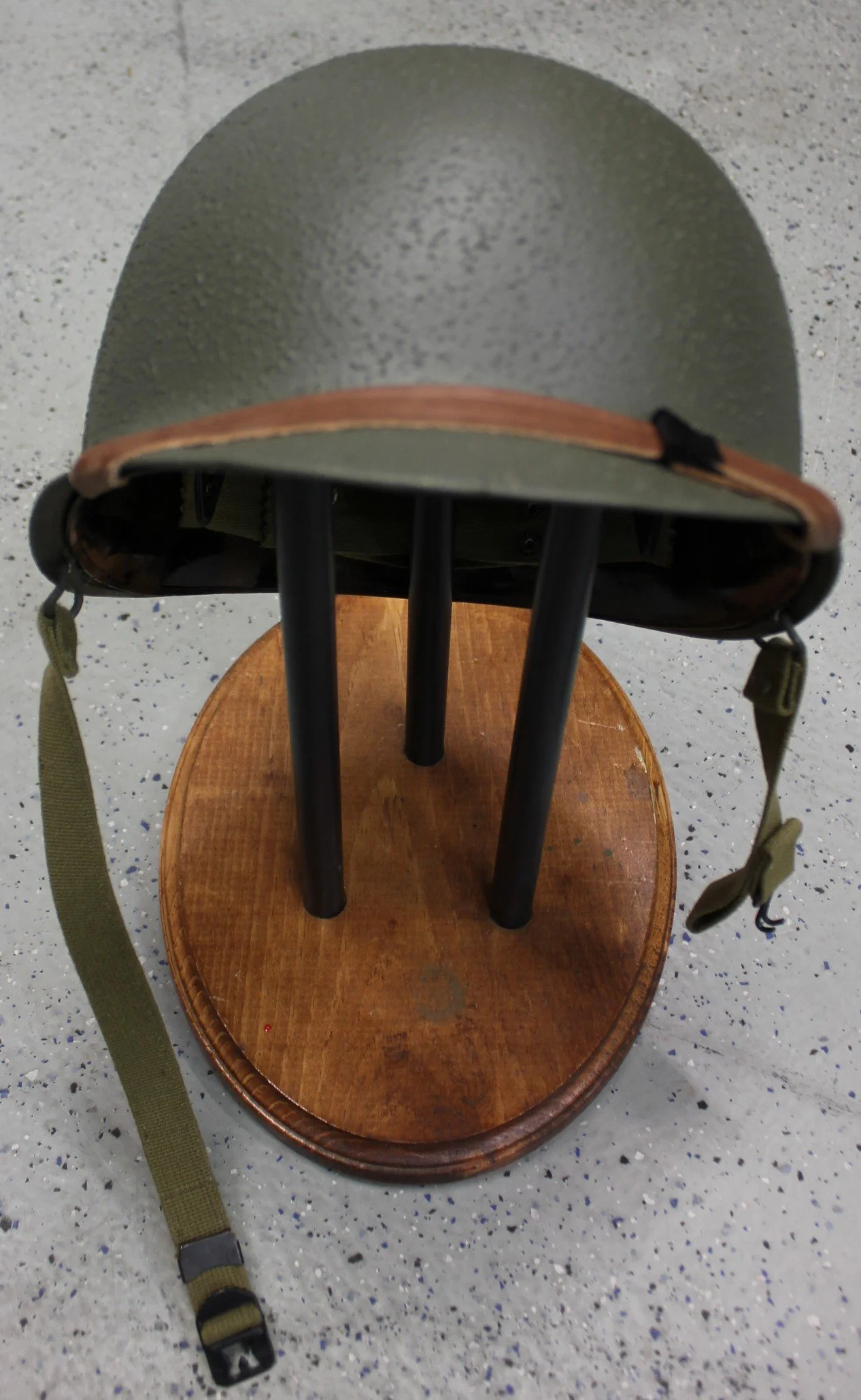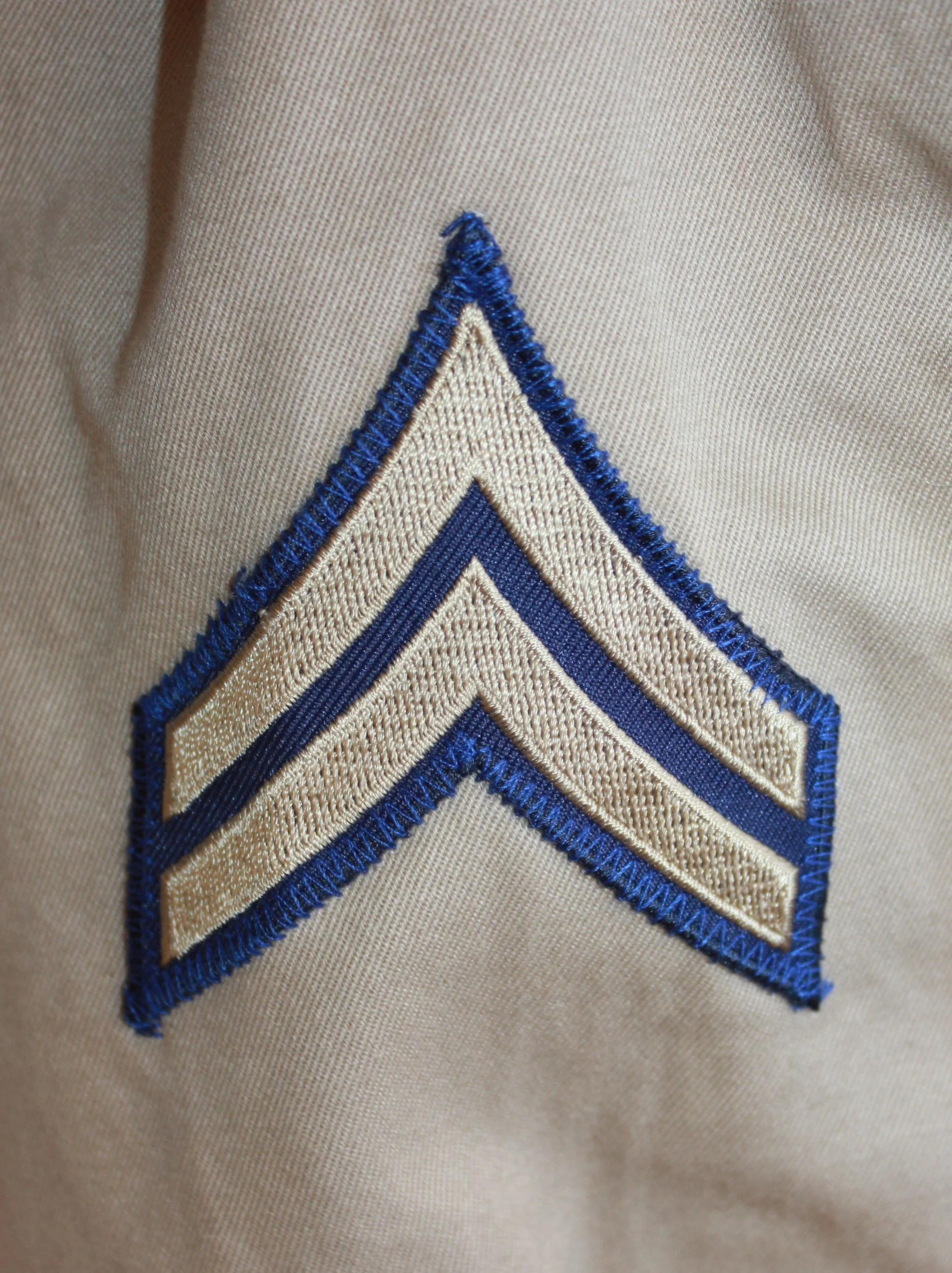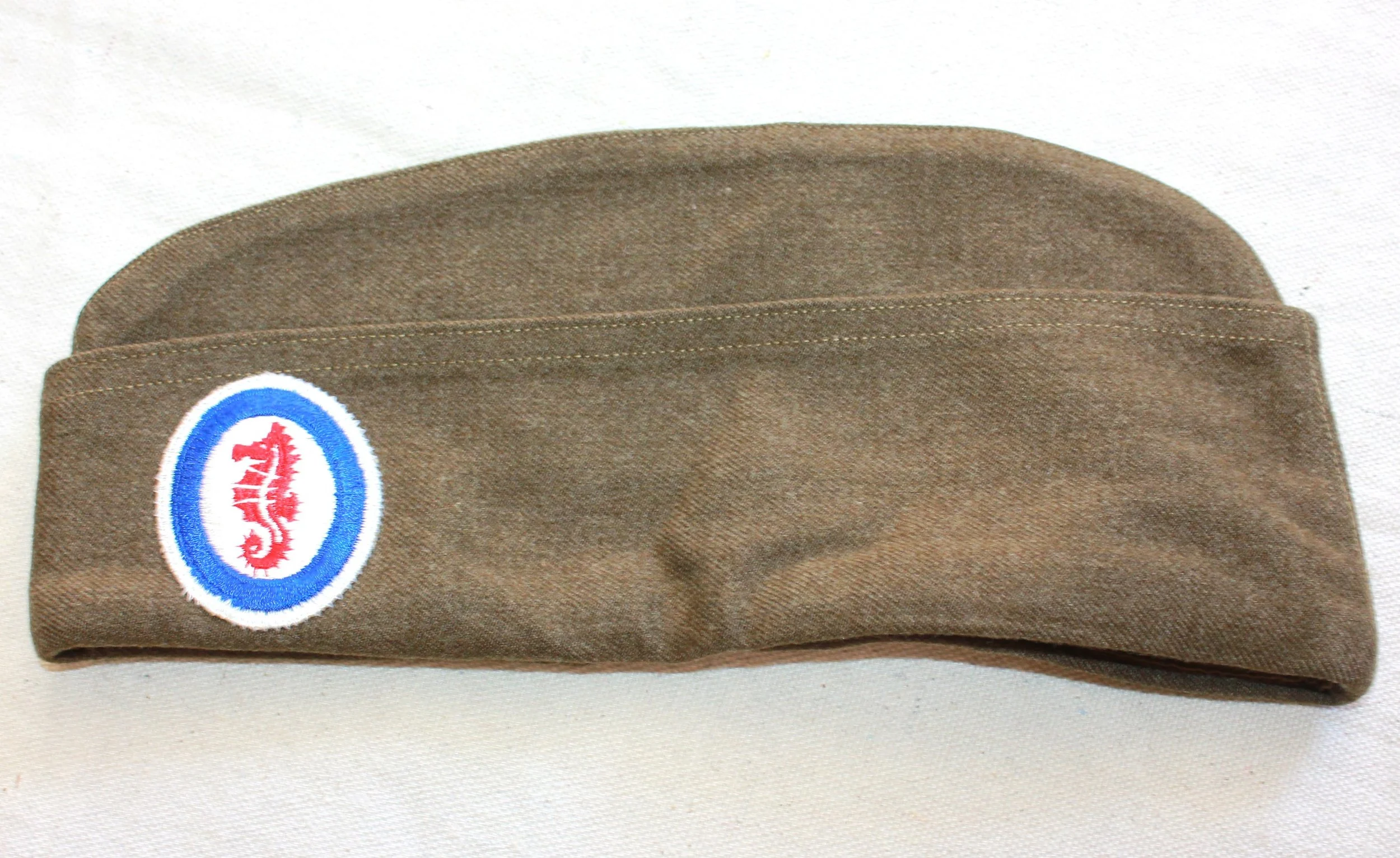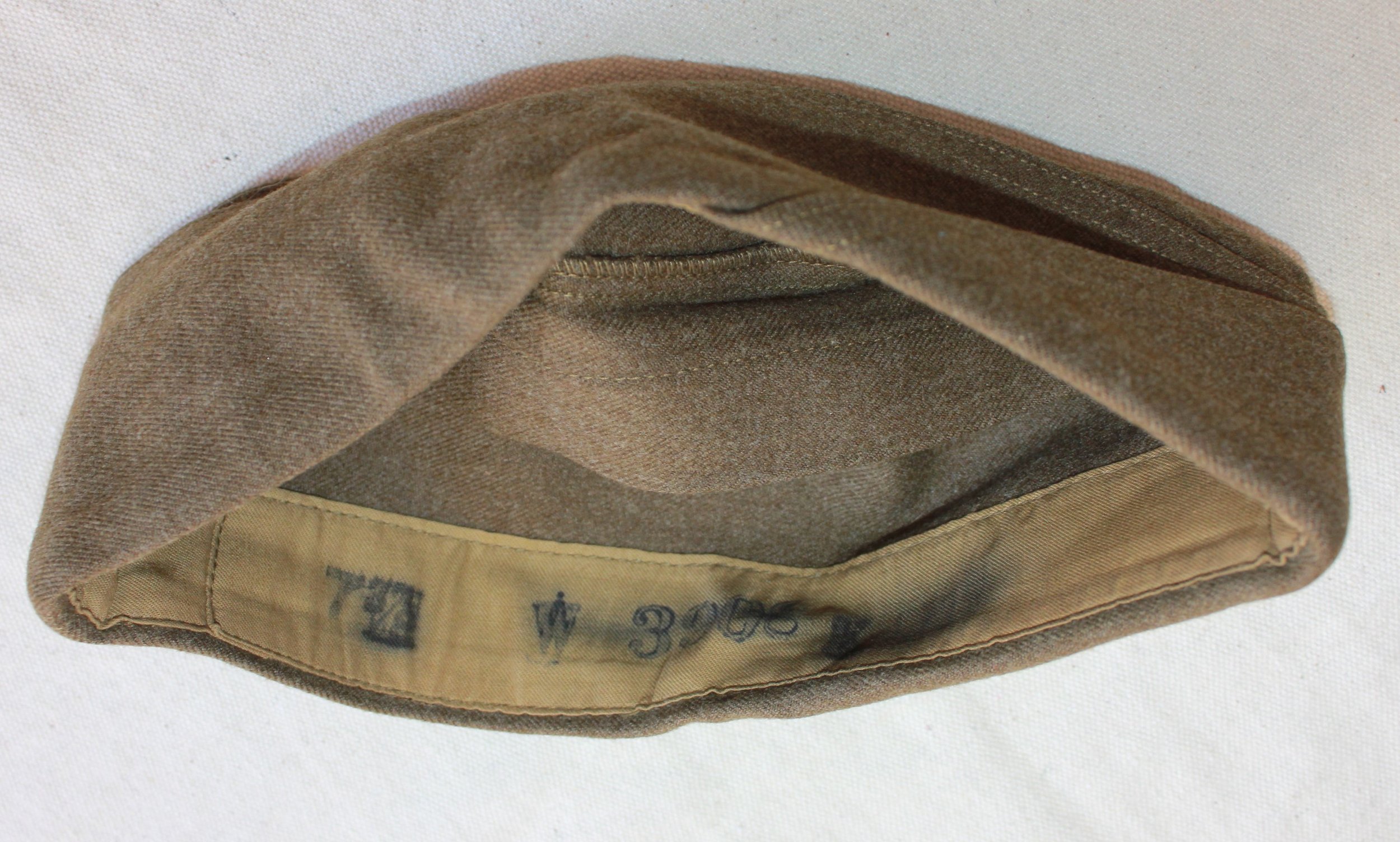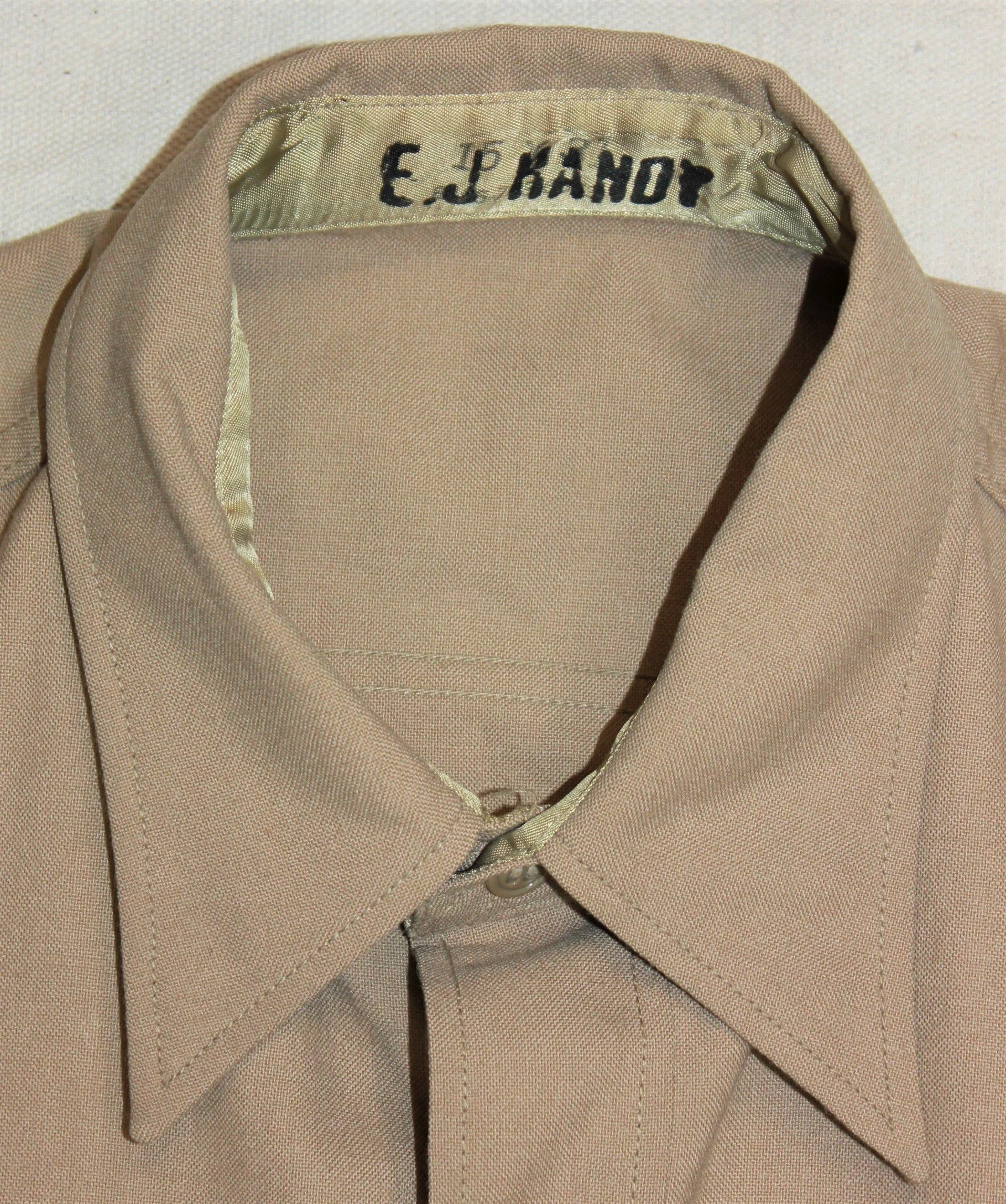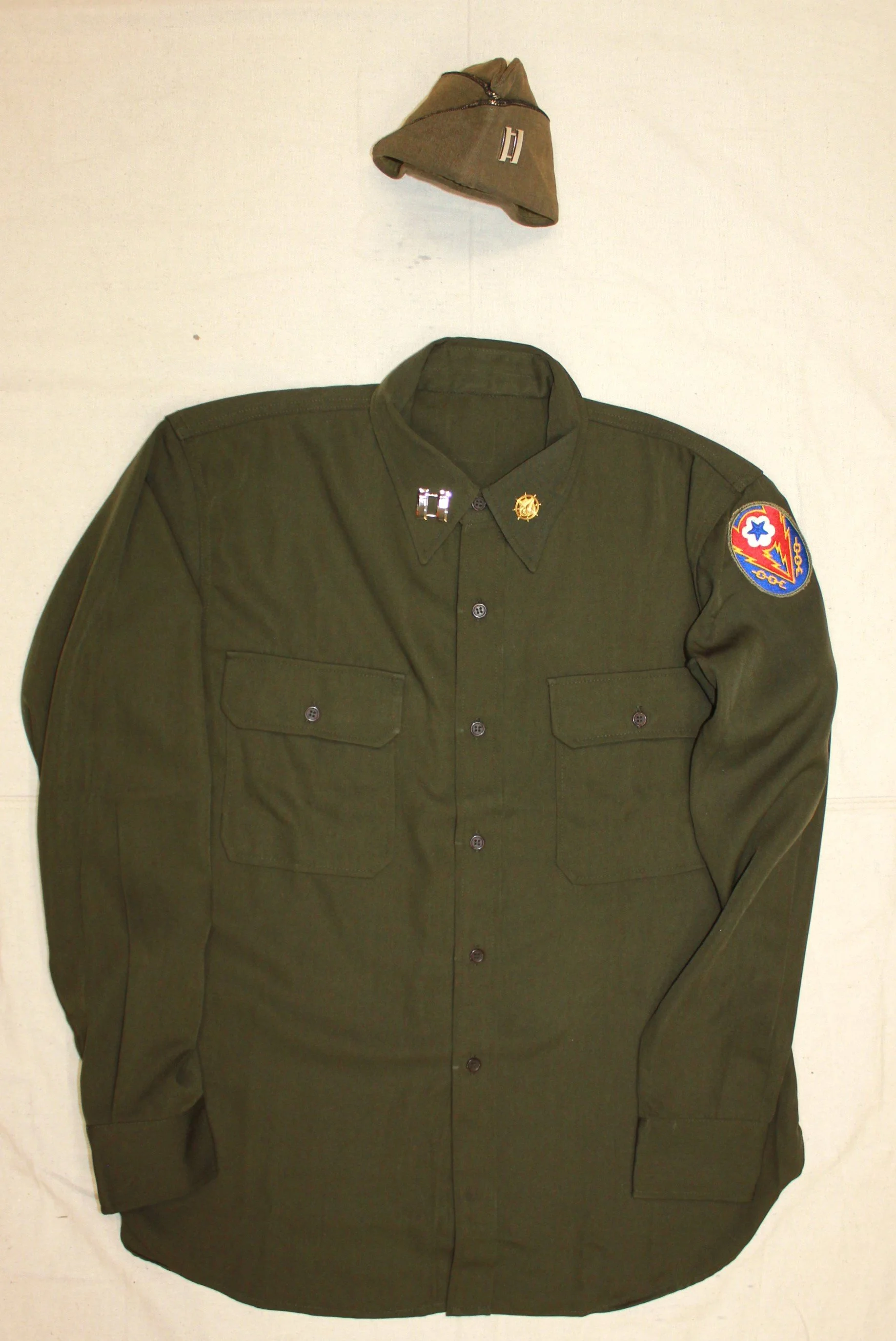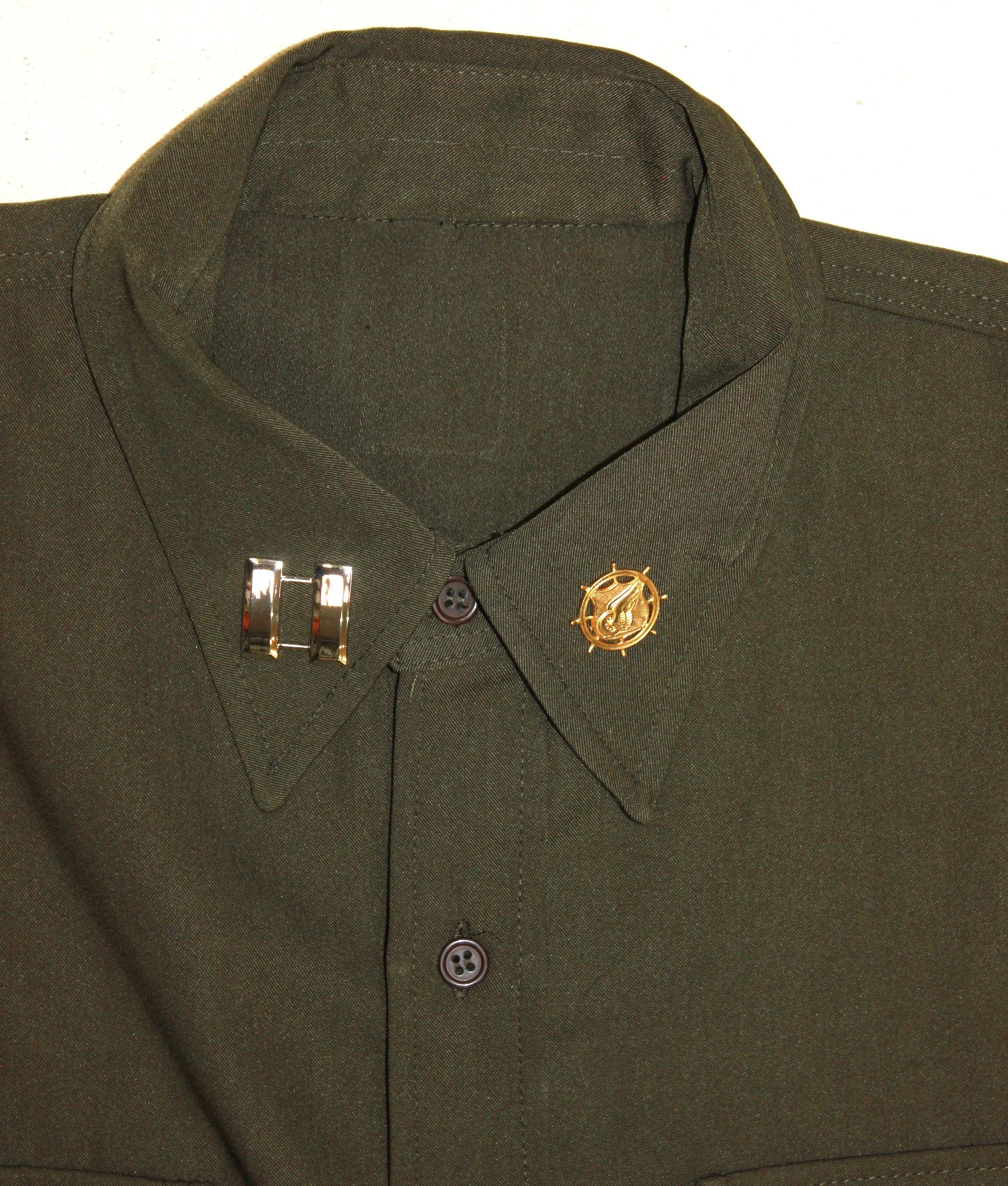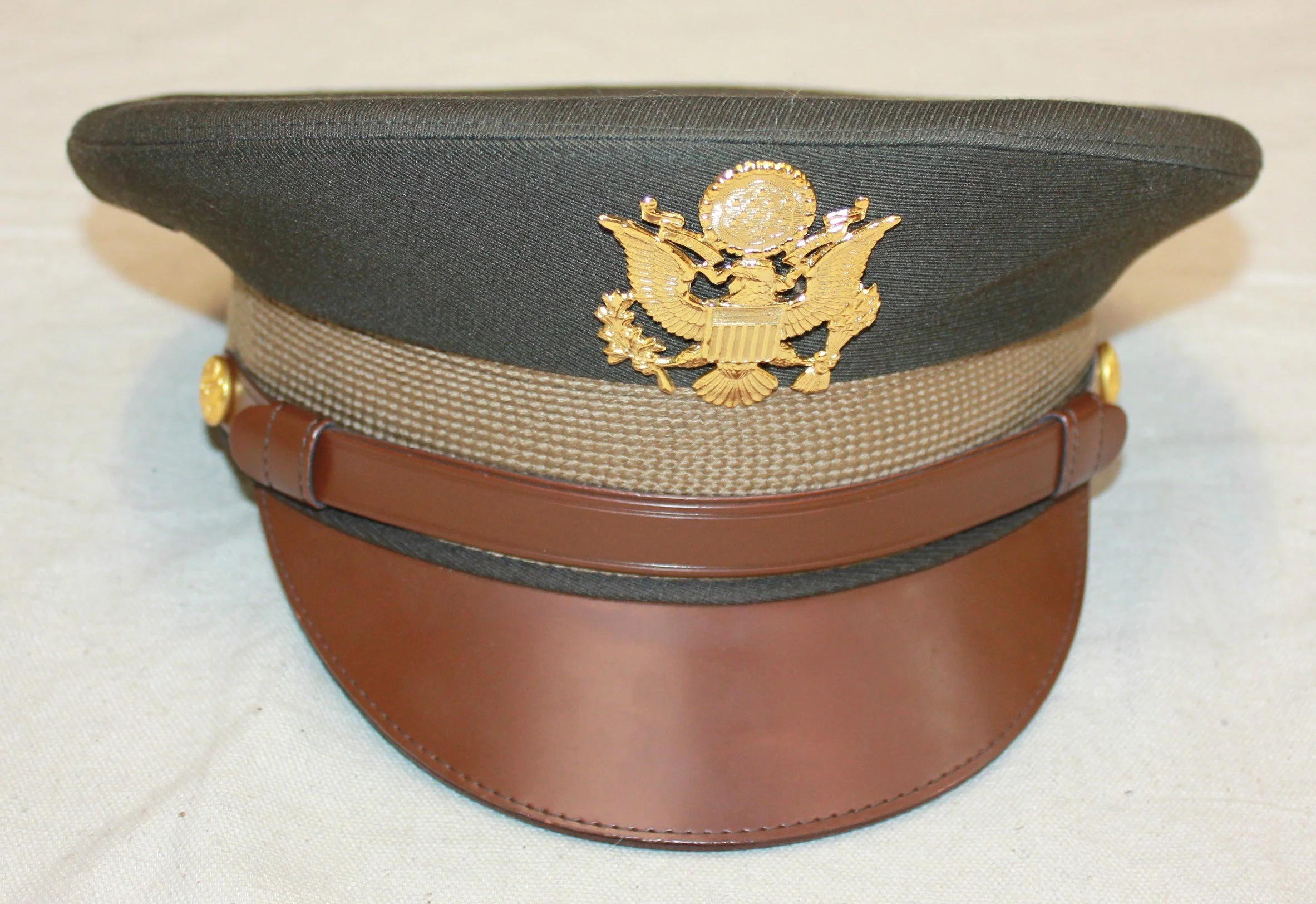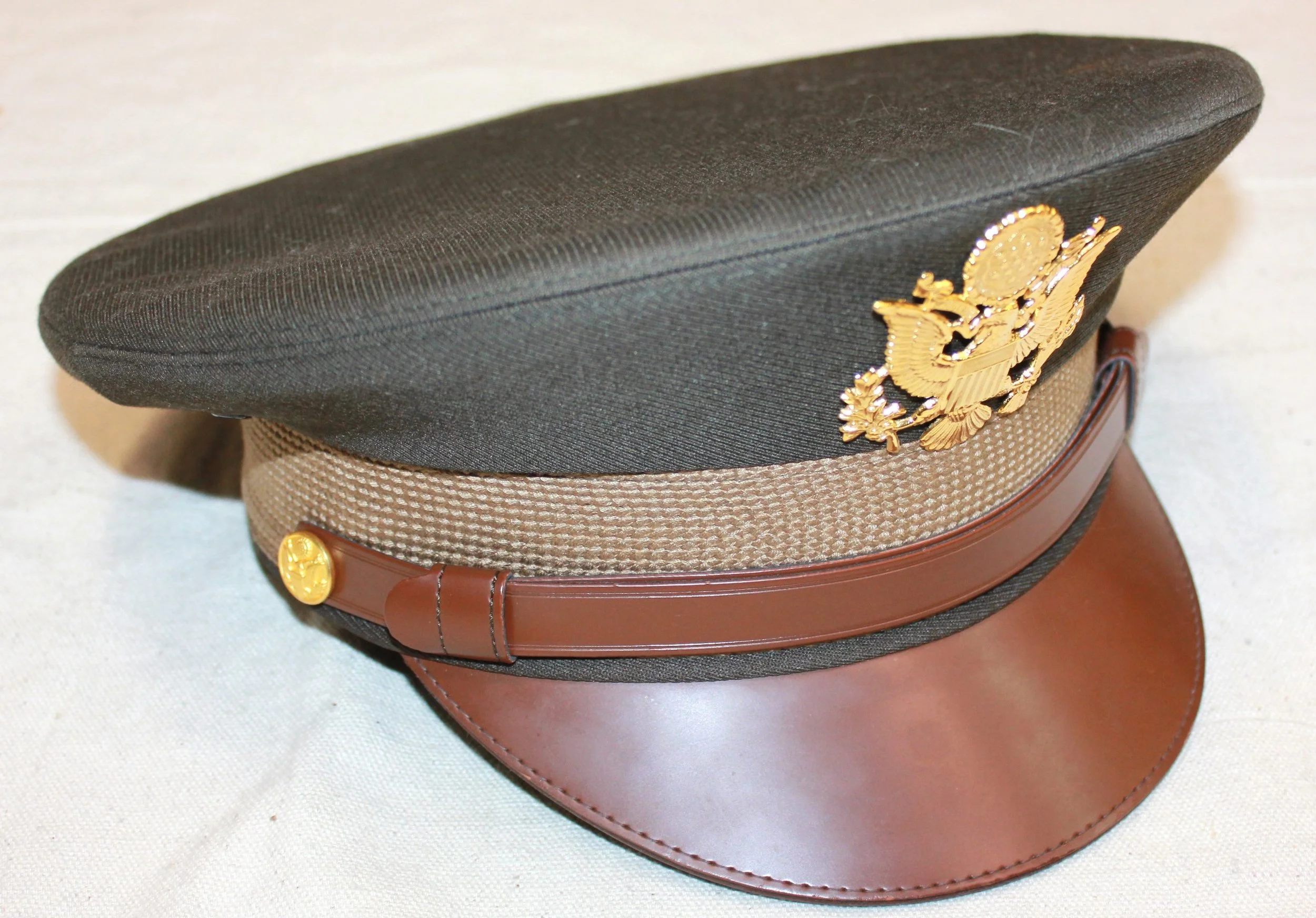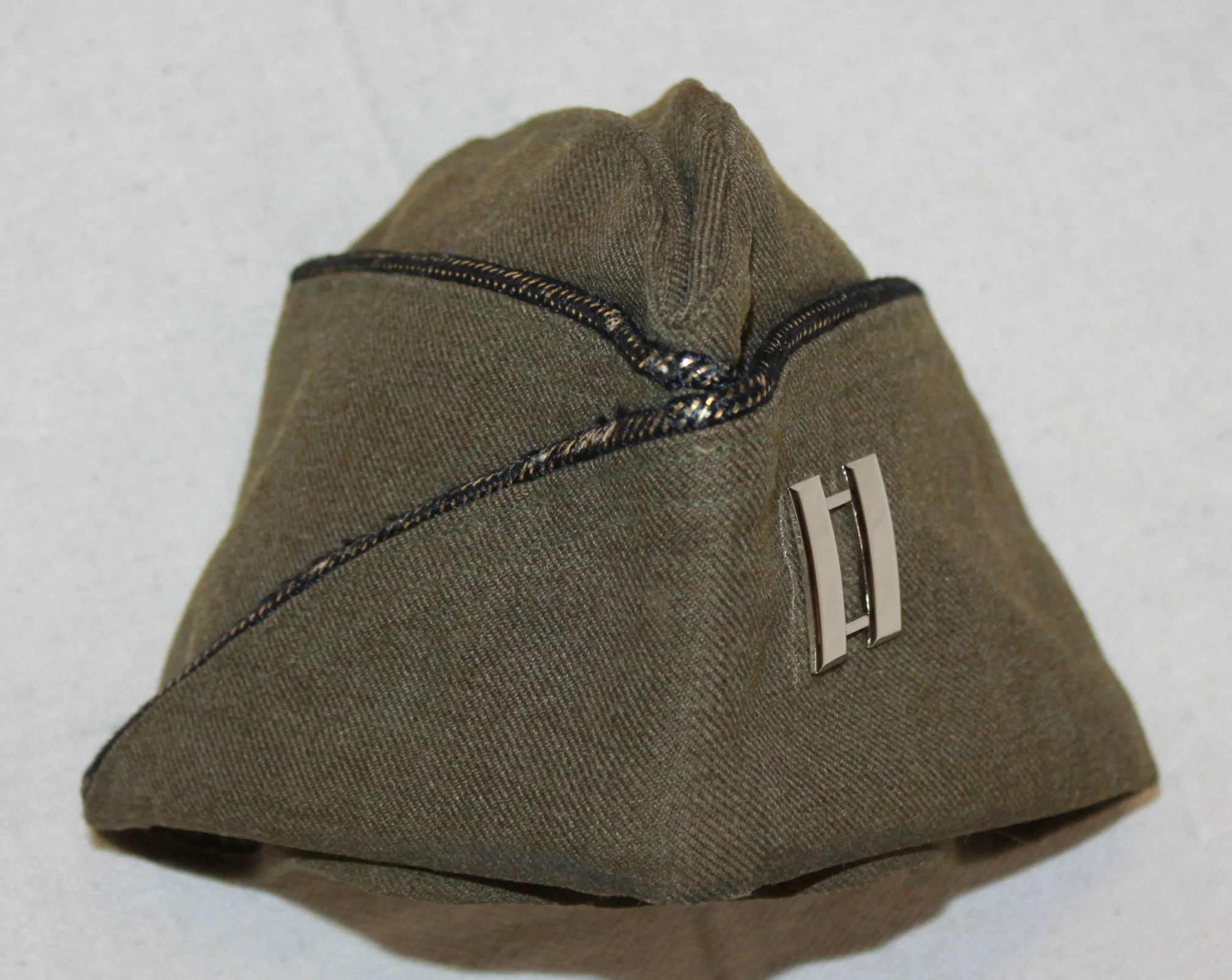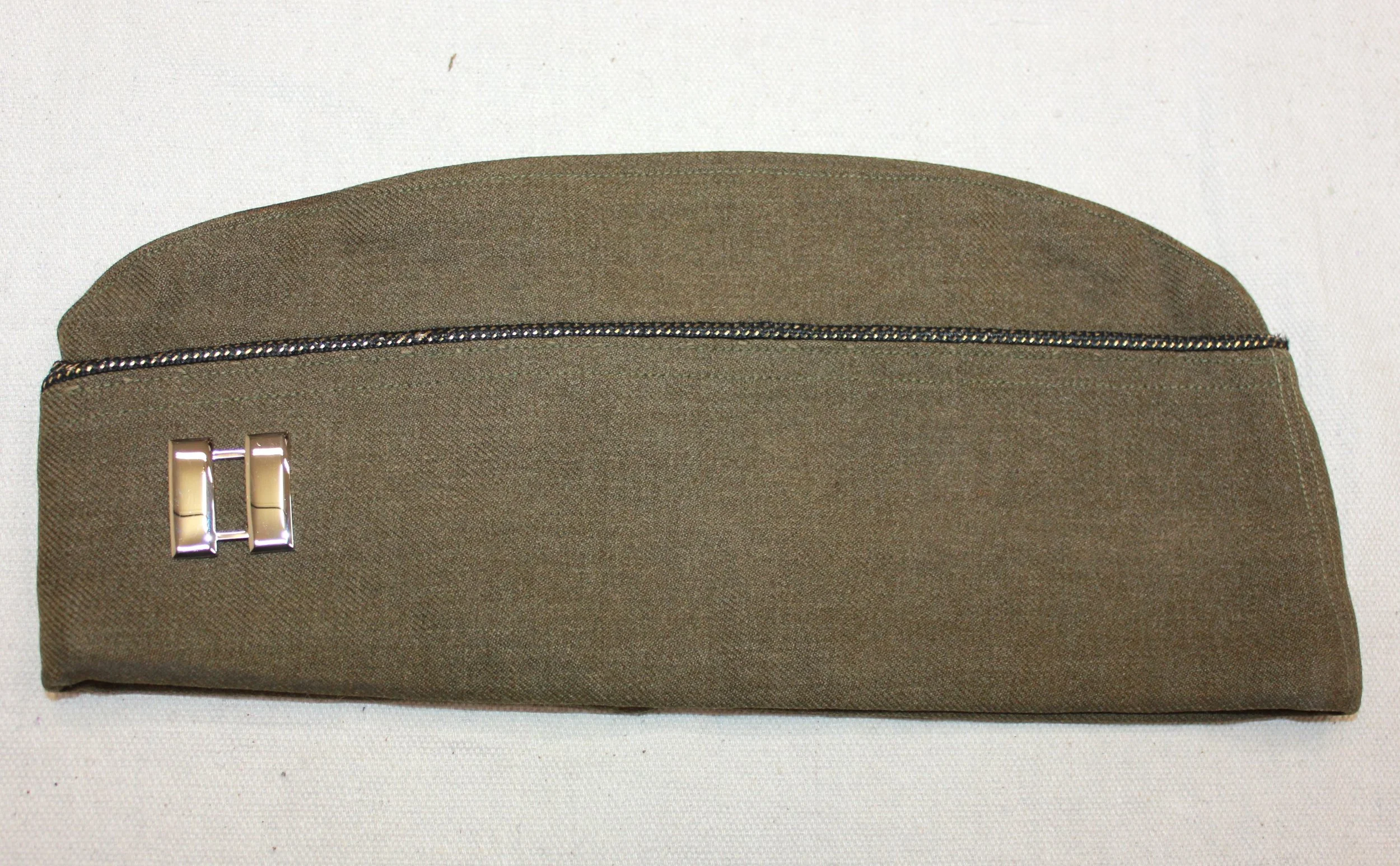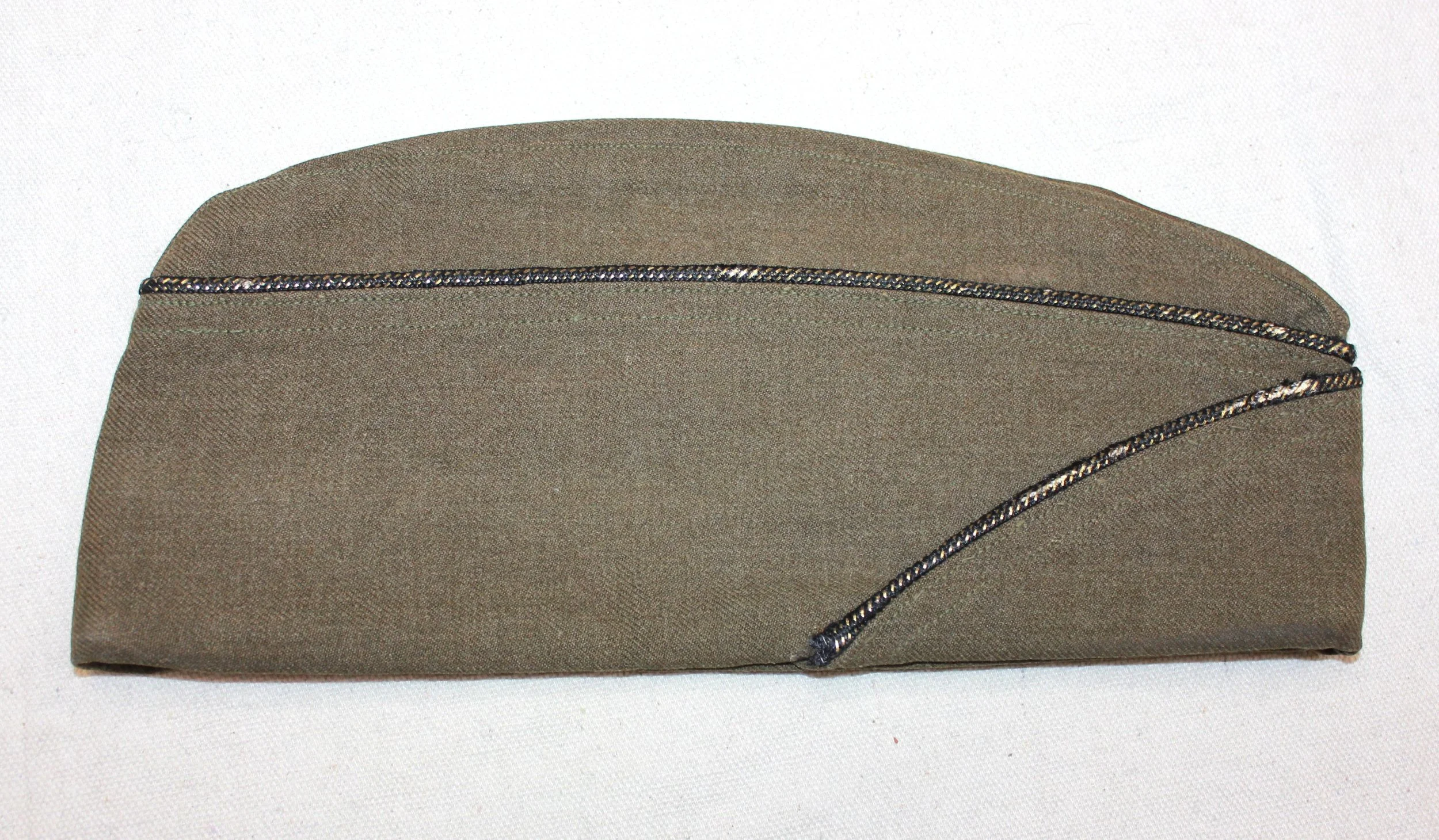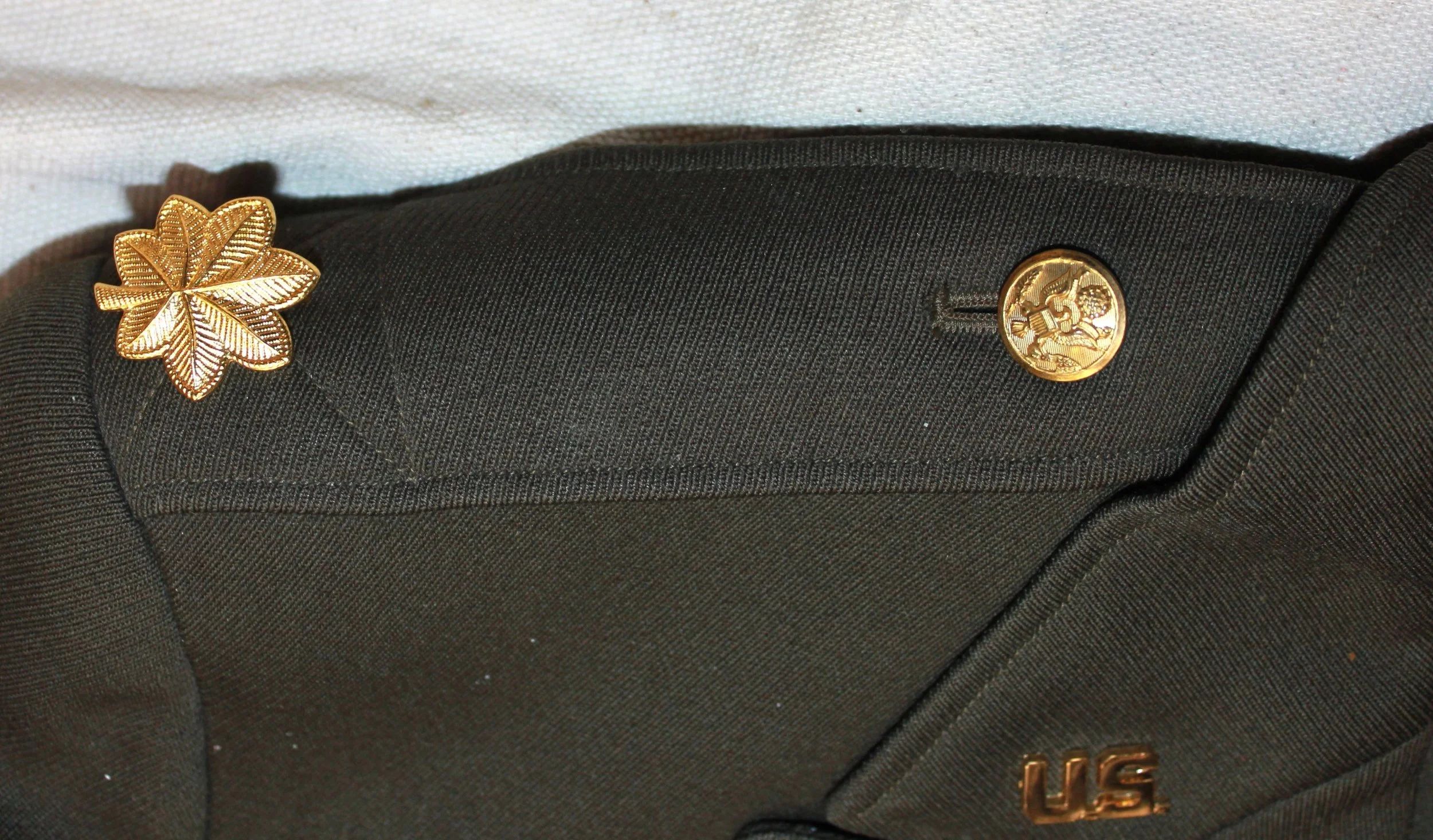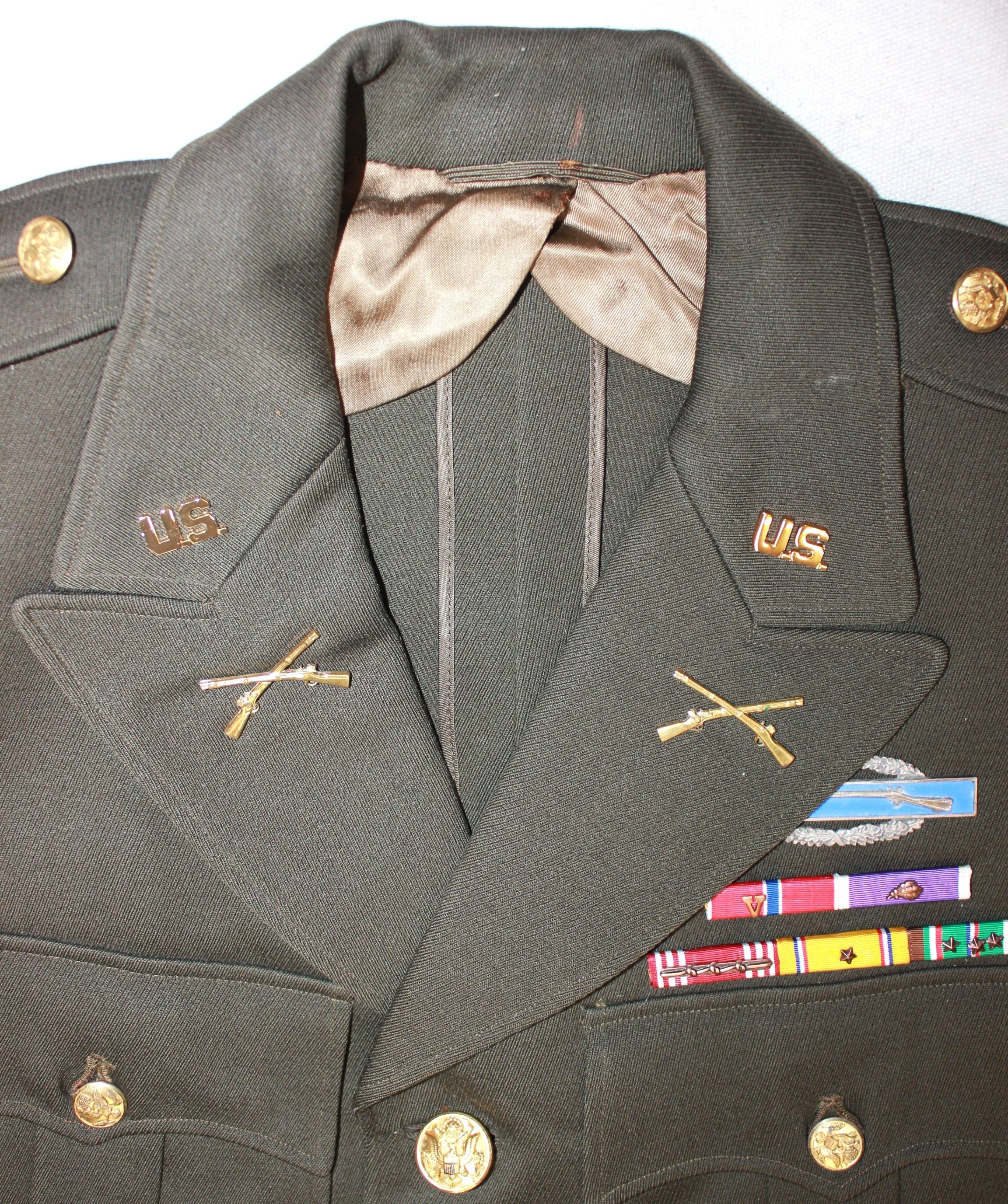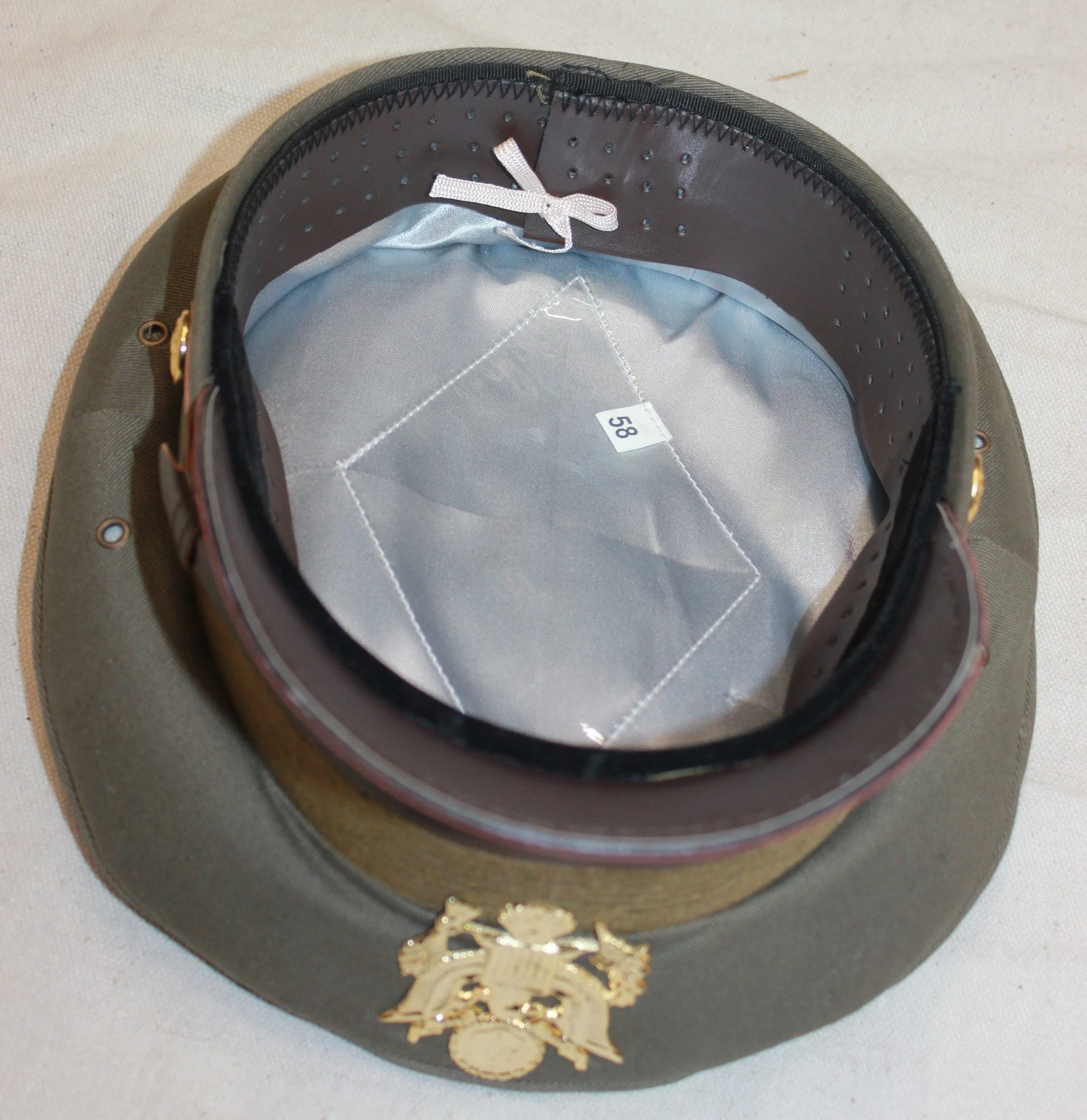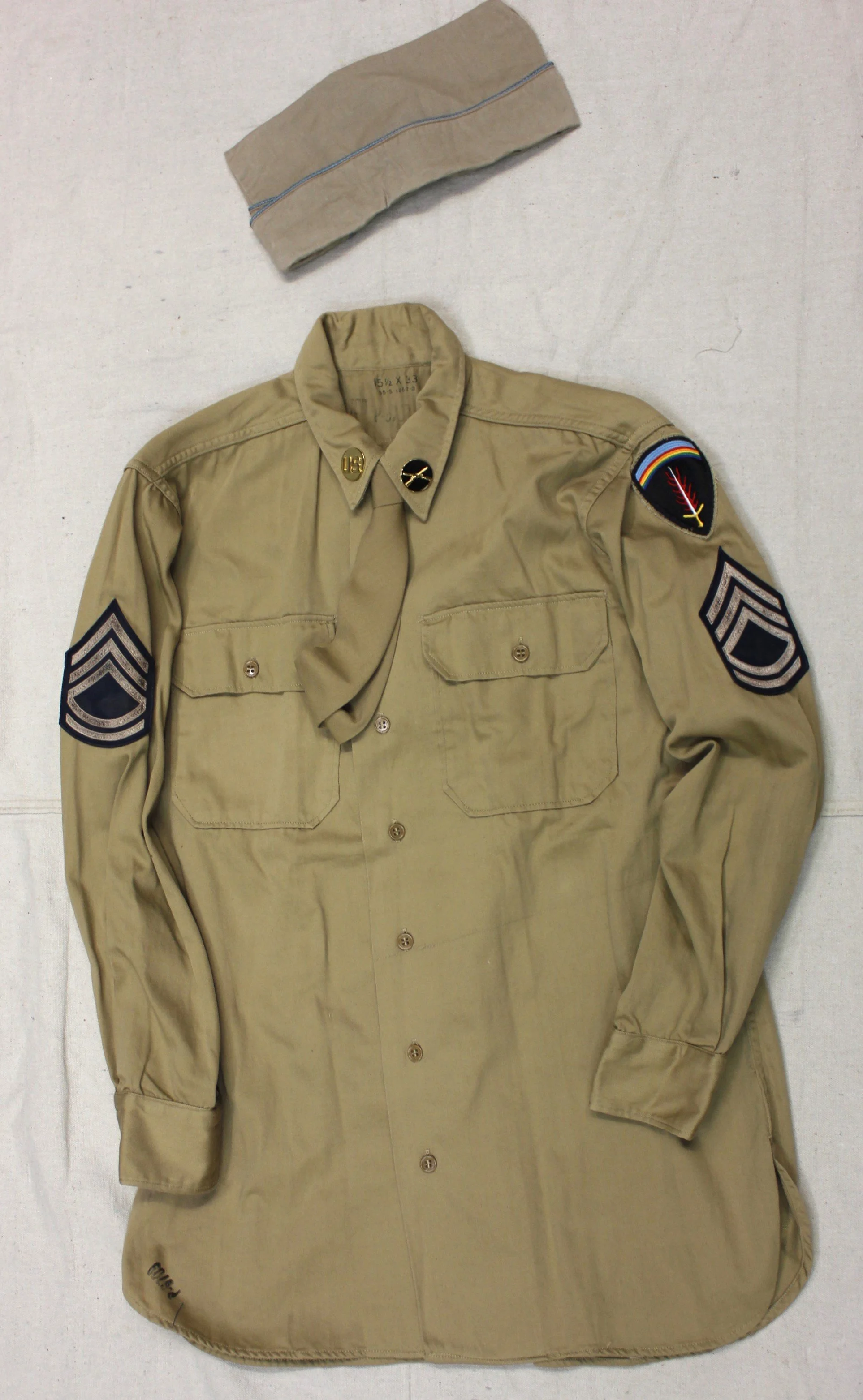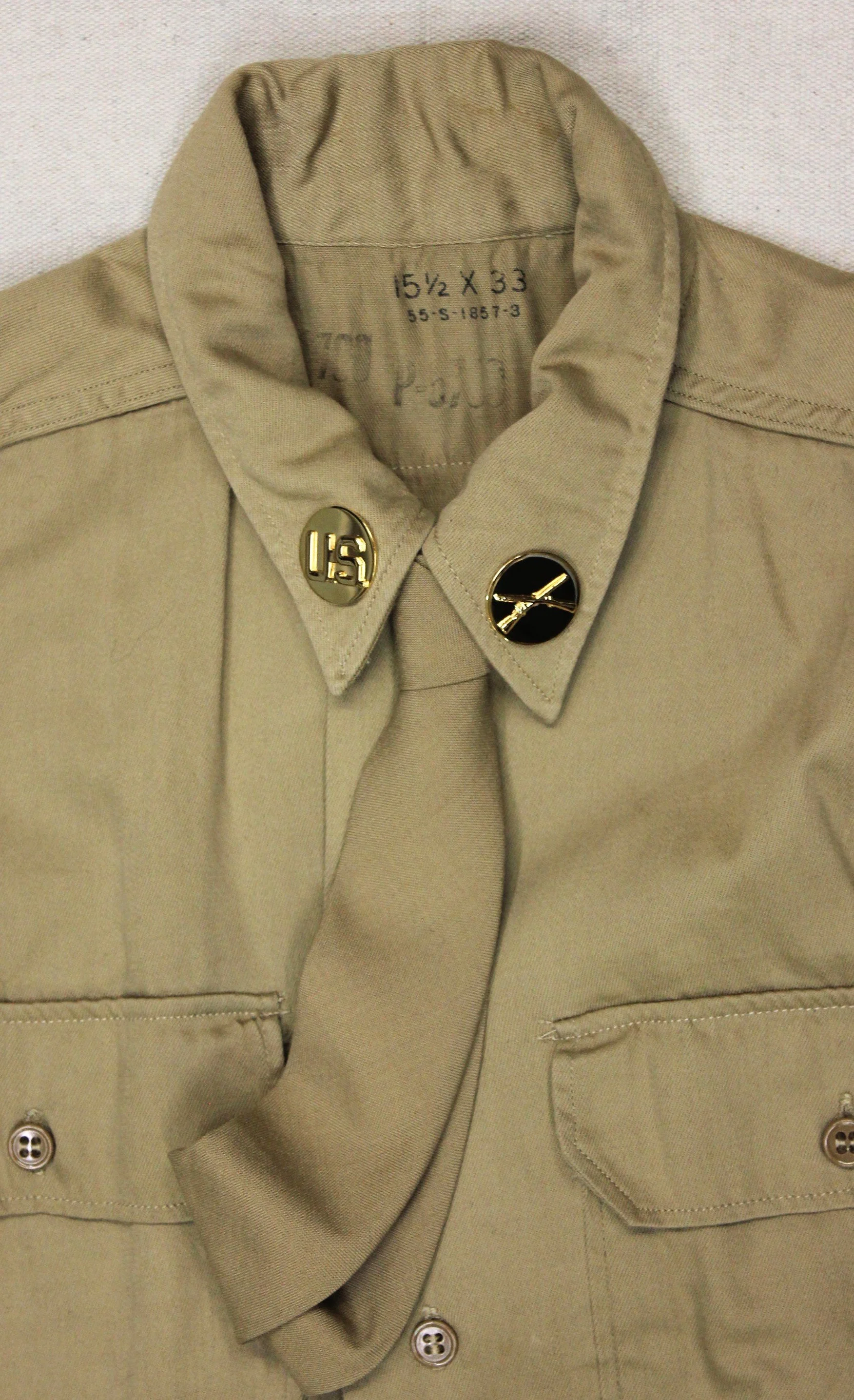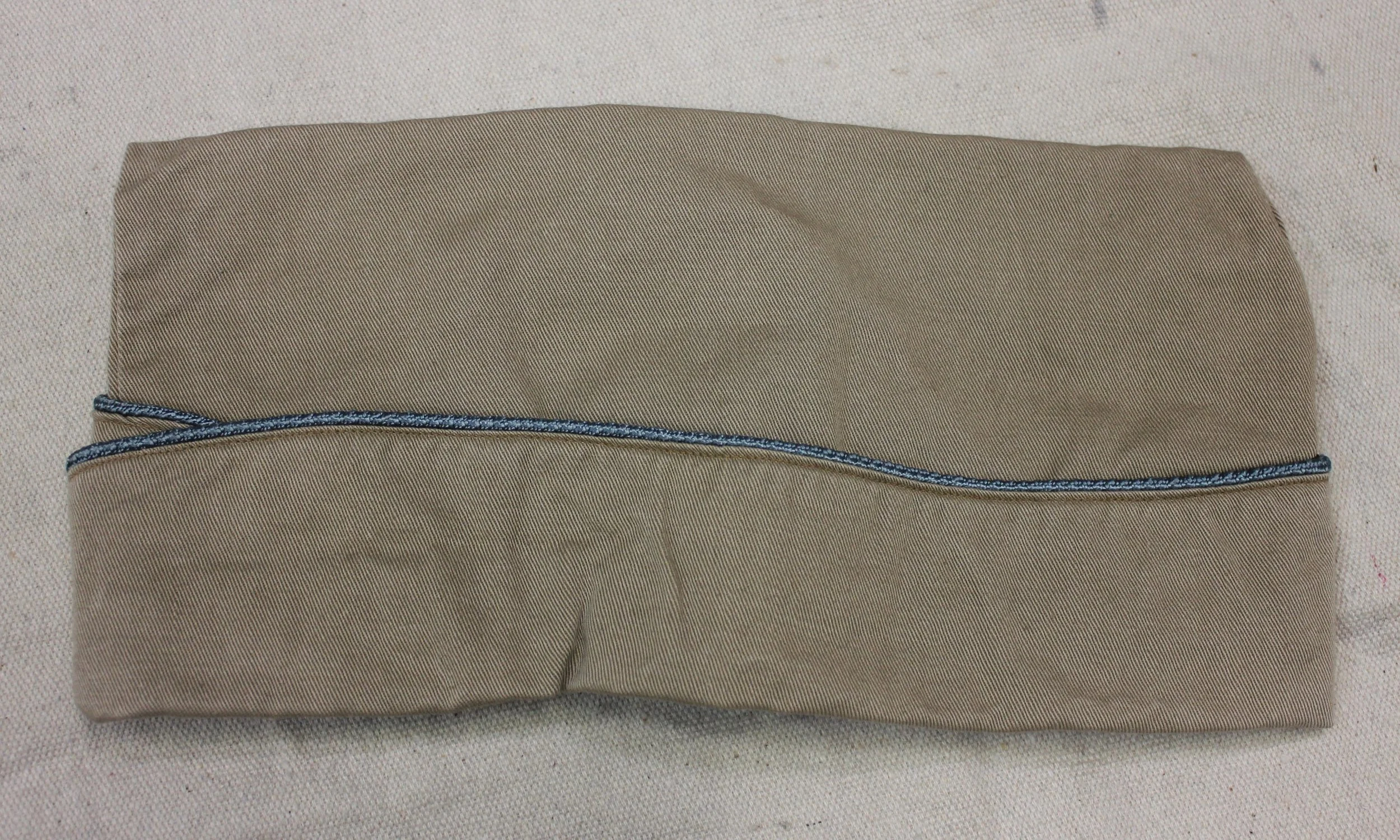U.S. Army, WWII, Other Units in Collection:
2nd Ranger Battalion, Corporal, 1944:
Rangers would build fame fighting against the Japanese and the Germans, and all over the globe, still operating with 4 or 5 main groups of Army Soldiers-always trained up, and always ready to go anywhere.
Leaving the ship-the ride in got really exciting- I should think the actual assault depicted quite well in the famous movie with Tom Hanks in command, quite accurate, and nothing less than that kind of chaos of battle there, quite unimaginable and disturbing, it never stops to amaze me what humans are capable of doing to each other, absolutely murder each other to follow a politicians orders, but to help protect their buddies.
This is like D-Day plus 1, the actual place they climbed up and took, to relieve the pressure on the min landings.
The US. Rangers served in the Revolutionary War, and Civil War, it would be some time, but they were formed back up for use in North Africa, at El Guettar, Italy at Salerno, France they would land at Pointe Du Hoc, and fight there way into Germany to the Saar River Area and beyond, other ranger outfits would serve the Pacific Operations, and in the China / Burma Theater. Then would come action again in Southeast Asia as Recon teams.
It was on 1 April 1943 that the 2nd Ranger Battalion was formed at Camp Forrest, Tennessee, beginning their long legacy of battle in WWII. Along with the 5th Ranger Battalion. Both were activated in September of 1943 and soon boarded ships and were sent to Great Britain and learn from some of the English Commandos, who had to show them all this training, in Operation the Normandy Landings, known as 'Operation Overlord, that came on June 6, 1944. They were but one of six Ranger battalions that served during WWII.
For their assault, they would involve Dog, Easy, and Fox Companies, led by Lt. Colonel James Rudder. They were assigned to take control of Pointe du Hoc and were assumed to be the major threat to the main landing beaches. They were to ride in on Small landing craft and modified DUKWs, "Amphibious Trucks" driven by the Royal Navy. Some 225 Rangers crossed the English Channel, Sea-sick and disorients, and having to travel parallel to the beach due to the tide, they traveled and ate up time. They had bolstered the strength of the 2nd Battalion, obtaining members from what was formerly the 29th Rangers.
Several landing craft rolled over in the heavy seas, losing all the men in them. Others were taken down by artillery with 7.92mm and 2.0 cm weapons shooting at the waters as well, and many of his men drowned due to the heavy loads they carried; some were saved. They were to be at the base of the cliffs at 0600 hours, they didn't they were an hour late. And enduring and bloody followed.
About 190 Rangers survived the boat ride, and landing and started up the cliffs using ropes and ladders. There were only 90 Rangers still carrying weapons after two days of the battle. They did take out a battery of 155mm French artillery captured pieces, the primary objective. These guns were sighted on Utah Beach, where absolute pandemonium was happening but had these weapons participated in the beach assault, and the Infantrymen had been sucked into a crossfire across the Normandy landing beaches, the outcome may have been quite different.
Able, Baker, and Charlie Companies, and the 5th Rangers, with the 1st Infantry Division and the 29th Infantry Division, landed on Omaha Beach (Bloody Omaha they would call it) all suffered very heavy losses, but eventually, they took their objectives for that day. Able alone lost 95% only two men made it off the beach. The 2nd Rangers would rebuild and serve again in the Battle for Brest, then in the savage fighting in the Hürtgen Forest, where they helped lead the way of the assault on Hill 400, and then Bergstein.
I've heard it said that the helmet marking was painted over but the time of the Normandy Landings, and I haven't yet seen pictures with them...so maybe this would then represent their training period. The battalion was deactivated after the war with the typical downsizing process, taking with it the 5th and 6th Battalions. The 2nd Ranger Battalion was reactivated on 1 October 1974, as an elite combat unit eight months after the 1st Ranger Battalion. The 2nd Ranger Battalion's colors and lineage were passed from Company H, 75th Infantry Rangers, of the Vietnam War. The most decorated and longest-serving unit in LRP/Ranger history.
Technical, 3rd Engineer (Special) Brigade, “Ike Jacket” WWII era:
American citizen Soldiers joined up in hordes after the attacks on Pearl Harbor in December of 1941, and it was not uncommon for young men only 17 years old to get in some as young as 14; they were trained up, as the armed forces geared up for war. Eventually, the country was ready to fight back.
The 3rd Engineer Special Brigade was assigned directly to the Amphibious Training Center, responsible for the training of various Army units in amphibious warfare until the dissolution of the Amphibious Training Center.
The 1st, 5th, and 6th Engineer Special Brigades were assigned to the European Theater of Operations, while the 2nd and 4th Engineer Special Brigades were assigned to the Pacific Theater of Operations.
After the Mediterranean and Europe, the 1st Engineer Special Brigade was assigned to the Pacific Theater of Operations, making it the only ESB to fight in both theaters of the war. Here we can see the Enlisted version of “Collar Brass", consisting of the U.S. and Engineer "Castle" on the other side.
He has a Presidential Unit Citation, on the right breast, Blue, with a brass basket around it, which I think originated during the Second World War. This was an item the Supreme Commander did to recognize a specific unit for the "Team’s Success" and a well-deserved award for the outfit, too.
Though the soldier of the Second World War was generally older than that in Vietnam, 22-26 in WWII, they were 19 maybe 20 in Vietnam, and in WWII there was no rotation as in the Vietnam Experience, of 1 year to 13 months or something, so they were always mixed new and old-the idea, was the old could teach the new guy-did not work that way. This soldier has earned the (CIB) Combat Infantryman's Badge and the US. Army version of the Good Conduct medal, so he kept his nose clean for four years, the Asiatic-Pacific Campaign Medal, with 3 campaign stars, basically 3 major landings, and the Philippine Liberation Medal. He has pinned on his Sharpshooters Badge as well, by regulation.
The Special Engineer Brigade was a very distinct insignia, and much looked up to, as a tough, hard Corps outfit, though-on the other hand, perhaps under-recognized in its historical importance at times.
Note the insignia is that of an Eagle over a Thompson Machine Gun, on an Anchor.
This Shoulder Patch is that of the Engineer Amphibious Brigade. There were various subordinate Engineer Boat, Engineer Amphibious, and Engineer Shore regiments; they were redesignated as Engineer Boat & Shore Regiments (EB&SR) near the end of the war.
There are two overseas bars (6 Months Each), so he did a year overseas (In the War). The wool/olive uniform is typical of the end of wartime, buttons would be changed to zippers on the Ike Jackets more and more into the '50s.
The changes in the uniform I am not an expert on, but the jacket was a spin on the British Battle Jacket, which Ike liked and wore all the time-and many Americans picked them up.
His overseas cap carries only the piping of the Engineers, no DUI.
“NEW” Corporal, Engineer (Special) Brigade:
The uniform represents a Corporal assigned to operate with Amphibious Operations, working with Naval personnel, in beach operations, either clearing them of mines and enemy soldiers, or landing allied soldiers onto them, then getting them, and their supplies, onto and off of the beaches.
The olive overseas cap may not fit the uniform as a “Summer Uniform” per se, but if the shirt is just worn for an inside-office work type purpose, I think fine, even in the wintertime, and could be paired up with the engineers ‘ jacket prior.
Staff Sergeant, 1st Army, MP:
The First Army was established on 10 August 1918. Some of the soldiers were involved in the fighting during the final weeks of the First World War (My Grandfather called it the “First War”, others the War To End All Wars. But afterword it became a paper Army, with no funding, and no one wanting to join, so the was a long period of inactivation. But they were Born-again, and the First Army was reactivated in October 1943.
They had complete operational control of all US ground forces deployed to England; V Corps had been doing the job. All the ground forces came under the First Army's control, in charge of the administration and the training of American Soldiers. Omar Bradley was in command. First Army, working with the British 21st Army Group. Taking control of the US field force headquarters and all 4 corps. Soon, plans would start to develop for the inevitable Cross Channel invasion, and the invasion of France, and the possible long-term plans for pushing the Germans back out. It became known as the Overlord Operation and would consist of Naval landing, support, and gunnery, combined with the infantry’s assault with airborne assets, and the Air Corps softening up the area, and for air/ground support that would prove completely devastating. Even Resistance Fighters sprang into action, disrupting travel, cutting telegraph lines, and rail supply, dropping important bridges, and creating general chaos in the towns.
Supreme Allied Commander, General Dwight Eisenhower, decided, due to weather complications, to give the “Go Ahead” with the operation starting on 6 June 1944. It did not go well from the start, but it didn’t stop either, the soldiers pushed on and bit by bit, gained a foothold, with great loss to themselves and the enemy. But the 1st Army had done its homework and made things happen. And Bradley’s men landed on Omaha and Utah beaches in Normandy, pushed across those beaches and the cliffs, and through the lowlands and into the hedgerow area, which had been somewhat overlooked, and not realized their presence would have on the fighting, slowing it down to a snail’s pace, and at high cost.
At this point, Lieutenant General Courtney Hodges was Bradley’s deputy commander of the 1st Army. But in August 1944, Hodges took over command because General Bradley had been reassigned to command the 12th Army Group.
‘Troy Hodges' soldiers were the first Americans to enter Paris, after pushing out the enemy. The next major battle was in the Ardennes Forest in Belgium. They pushed up to the Siegfried Line and crossed it, heading into Germany by September of 1944, and to the edge of the Rhine in March 1945. They met up with the Russian forces at Torgau in April 1945, and soon after, the European part of the War came to an end. Troy Hodges was promoted and the second man to get to the rank of 4-star General, rising from the rank of enlisted private, his entire career was as a soldier. Now that the story got out of hand fast.
The 1st Army’s patch, officially a white square over red, overlaid by a black ‘A’, Seen here is one of the early subdued formats, particular to the 1st Army, the center of the ‘A’ having the ‘Branch Color’ of the particular soldier in small, colored and outlined square, here the MPs (Yellow and Green). The Helmet is encircled with a yellow band, rather than the normal white. The Yellow pertains, I believe, to the Brigade level of control; Red and Blue were also often seen. The Arm Band, thought to be black-backed, was often in fact blue-backed with white MP over it.
24th Repo-Depot, Temporary Assignment:
A place where you do your processing, the country, not having the Purple Heart, it would appear, coming home or coming back from leave. Many did not get these in WWII; they were with their outfit from the time they got there, till the war was over or the unit disbanded. Having served in a prior battle with the 24th Division, He now sits at a Repo-Depot. So, this is a good representation of one of the men who had likely finished his time at war and was on the way home, and the transitional time was when a soldier often left his unit, and was sort of in limbo, going through the processing of getting back to the States, and Home, but lost without his buddies and the team.
There is the chance he has been assigned a job at the facility, perhaps in the re-assignment role, the brass on his collar identifies him in the infantry field, A Staff Sergeant, he has a little pull so to speak, let's see what possibilities we can come up with looking on the net…
His prior service tells us he was with the 24th Infantry Division, known as the 'Hawaiian Division' and he fought in the Tropics during World War II, we don't know for sure, but his ribbons bar has the Pacific Theater ribbon that has 3 campaign stars on it...maybe operations on Hollandia, and the landings at Leyte, and one ribbon tells us he went to Luzon, where the Liberation was enacted, obviously and infantryman with his CIB, and Shooting qualification badge, he could be sitting at the Repo-Depot, after the war ended, as he has over 3 years with of battle bars on his sleeve. Possibly, he’s waiting in Japan, doing Occupation Duty.
Just guessing here, but he may have been wearing this at Replacement Depot in Japan following the surrender of the war, and the uniforms in a dress uniform, the 8068th, Replacement Depot at Beppu, and there was the 8069th Depot at Sasebo in 1945, as they patiently wondered what would come next.
The Ribbon’s Bar is something that carries over to today, but the ribbons no longer have this water-proof plastic over them, and like most who served during WWII never really received many recognition ribbons, and only ever received the minimum amount of 2-3 ribbons...not to say they likely did way more than was acknowledged for, it was a common situation.
The Depot’s idea was to be able to have new, fresh troops standing by for an assignment to a front-line outfit- or where manpower would be needed, so the units in action could always be at full strength. This did not exactly turn out to be the case.
The right shoulder holds the patch of the division you last served within the battle on prior overseas duty. Apparently, a lot of these men would be the guys that would suffer more combat fatigue, as they felt like outsiders, not belonging to the unit assigned, and there were a lot of casualties with the new troops operating with older, wiser troops- the new guys felt to be cannon fodder.
The men in the Depots would suffer poor morale, be bored to death, and would leave in worse shape than when they arrived. They lead to worse attitudes when assigned to the front-line tight outfits, with new guys no one knew or trusted, and you must earn trust. His 24th patch on the right sleeve depicts the outfit he served with overseas (In Battle), and thus this is likely the 'Going Home Suit,' so he's styling it when he gets off the boat in the States...
A Staff Sergeant, he's coming home with battlefield promotion quite likely, and maybe one of the few bonuses he got from going to battle, he may choose to pass on his knowledge of how to go to war, but most would be calling it good- time to get back to the life they left and start catching up there- that in itself would be a hell of a challenge, and with a million out of a job-tough to find work. Having served 3 years overseas at war, it is also likely his skills as a civilian are at an all-time low as well, and now 50,00 guys are looking for work too. Overseas Bars x 6, that's a long time away from home. He has forgotten what home was like. That's a long time to be 'At War', and in WWII, that was not 3 times back and forth, they were 3 years in conflict before coming home...
I don’t show the backsides of the uniforms very often, so here is one of the WWII Olive-Barracks jackets’ backsides.
His Garrison (or Overseas Cap) as I call them, is typical of the time, they say the short top- and/or rounded top panels (In the center) mean it was an issue, as opposed to the higher squared-off style, the word is they are PX bought, or from out of the country makers, but I have no proof of this.
There may have been early and late models as well, but I have no factual information on it. I assume there were so many soldiers needing equipment in such a short time at the start and end of the war that mass manufacturers were producing these, and a variant was just what happened. It is sort of different how he added the brass to the cap, I've heard stories that so many men were moved through the training phase the regulations were often bypassed to get men in and off the field, and some soldiers just really didn't know how to pin-up the uniforms for base use on returning home- though I assume on board ship, an officer was pointing these details out...because he too was bored to death.
The simplicity of construction here is obvious, and most of the countries at war during WWII had some form of this cap, a carryover from the first war. The blue piping, of course, denotes his infantry affiliation.
Enlistedman, “Seven Steps to Hell”:
The Seventh Army was the first U.S. Field Army to see combat in WW II, having been activated at sea, when Lt. General George Patton’s I Armored Corps was redesignated on July 10th, 1943. The Seventh Army landed on beaches in southern Sicily, fighting there and taking the city of Palermo, and the British Eighth Army captured Messina in mid-August. Elements of the Seventh Army had killed or captured over 113,000 enemy soldiers. In January of 1944, Lt. General Mark Clark was assigned as Commander and started planning the invasion of southern France.
In March of 1944, Lt. General Alexander Patch took command of the Army and then moved to Naples, Italy. Seventh Army units landed on the beaches of southern France in the St. Tropez and St. Raphael areas on August 15th, 1944. In one month, the 7th Army, composed of three American Divisions and five French Divisions, along with the First Airborne Task Force, covered 400 miles to link up with the other Allied forces in Normandy. They had liberated the cities of Marseilles, Lyon, Toulon, and Southern France.
The 7th Army thought the German forces in the Vosges Mountains, and broke into the Alsatian Plain, they took the city of Strasbourg and continued onto the Rhine River. Then came the Battle of the Bulge, and the Seventh Army covered the flanks, taking over a lot of the Third Army area, allowing them to move towards the surrounded U.S. forces at Bastogne. Then, with the French First Army, they opened an offensive in February 1945, annihilating the German pocket in the Colmar area.
The Seventh Army fought through the Saar, then crossed the Rhine, capturing the cities of Nuremberg and Munich. They crossed the Brenner Pass and then made contact with the Fifth Army in Italy. The Seventh had been in continuous fighting for almost 9 months; they had covered over 1,000 miles and had commanded some 24 American and Allied Divisions.
The Seventh Army was inactivated in March 1946 in Germany.
Technical Sergeant, Administration Department, Persian Gulf Command:
The PG Command began in September of 1941, as the US Military Iranian Mission, with Colonel Raymond Wheeler of the US Army Corps of Engineers in charge. At the same time, the Iranian District of the North Atlantic Division was being developed for construction support. Re-designated in August of 1942 as the Persian Gulf Service Command, and in December 1943 became the Persian Gulf Command. Then it came under the command of other engineer generals. Following the War Department's full militarization of construction, the Iranian District ceased to exist in May 1943. With the three districts directly subordinate, eventually replacing it. They would also work in Iraq.
Iran was controlled by British Troops and Russian troops who were guarding the oil fields there and monitoring the pro-German Iranians, aka Persians. The German High Command believed their military forces could eventually take possession of the oil fields there, along with the railroad that went over the mountains from the coast to the Russian border, but they were wrong, and they never achieved their goal.
Major, assigned to European Theatre-Communications Command:
The European Theatre of Operations, United States Army (ETOUSA) was a United States Army group that controlled all US Army operations in Europe from 1942 to 1945. It referred to Army Ground Forces, the Army Air Forces, and Army Service operations north of the Italian Border, and the Mediterranean coast, which was the ETO area of operations.
It was bordered to the south by the North African Theatre of Operations, US Army (NATOUSA), which later became the Mediterranean Theatre of Operations (MTOUSA). I don't see him earning a bronze star in either Austria Command, or European Command status, generally a battle ribbon, he does not have any battle bars on his sleeve, or hash marks for his time in the military we don't know if he might have served on the front lines at some point in his career, he has no CIB either.... must have made a good call on some operational situation.
The Bronze Star (top left) shows he did have some front line somewhere, possibly in France, followed by the American Defence Service Medal, then the European / Africa / Middle East Campaign Medal, WWII Victory Commemorative Medal, and the Occupation Medal, all in their basic presentation, look no Stars or Arrowheads, etc.
Communication Zone Personnel, European Theatre of Operations, Advanced Sector. This organisation provided support, in the way of supplies, equipment, transport, and weapons, in the preparation for operations in Normandy 'Operation Bolero', and after the 'Break-Out' from the Hedgerow area, the 'Advanced Sector' delegated the task of supporting 1st and 3rd Armies from the HQ in Paris.
Prior service working at the Austria HQ. Forces. 'USFA' Headquarters was located in the city of Salzburg, but there were 4 other posts located in Austria as well. located in Vienna, Linz, Leghorn, Italy, Vienna was broken into 4 zones too, then there was the International Zone that was administered by the Inter-Allied Command. On the Major uniform are 2 rows of ribbons, the top row has the Bronze Star, and the American Defence Service Medal, and on the second row is the 'European / African / Middle-Eastern Campaign Medal'. WWII Victory Medal, and the Occupational Service Medal, none have any stars or other devices added, maybe just never applied.
To note how the command structure operated in short, there was the combat zone, which is the active area of fighting, and there was the Communications Zone, where the guys running the show were close enough for radio communication in other words, and they served to make battlefield decisions, and do the bigger picture strategy, and keep Ammunition, Food, and Transport, and firepower support coming as needed- or as they could.
The Communication Zone (Transport of Supplies) followed close behind the Combat Zones-Field Force, the guys with boots on the ground, were willing to push ahead better if they knew they had a plan, support, and something at the end: Ammunition, Hot Food, and Medical Assistance.
The uniform retains some of the war period items on it, the hooks for the belt being one. The jacket is in decent shape, and not eaten by moths, though I see them flying around all over.
It's a well-made item and fully lined. Officer Quality, if you will, portrays a place, a part of the big picture of the goings-on of an Army, and another part of the story of the war, and these uniforms in the collection. The uniform was from the 1944-45 period, I should think.
The tag, a rarity, is still in this jacket. I haven't researched this, so if it doesn’t match up. The jacket is an example, and I don't claim any are really someone even the ones given to me, which 5-6 have been or more; most had at least a badge or two we worked from to finish up the uniform.
The cap of choice here for the Major, is a crusher, now, we all know getting a jacket with the correct one would be a very lucky find, and in general, I try to show a uniform (as they looked) not 70 years later, eaten by bugs.... but this is what I had the I thought would fit with him.
The crusher is more of a fly-boy thing rather than a regular Army foot soldier. But it's near the same colour as an officer’s cap, so here we go, the Army was going into the post-war downsizing stage, and they were getting fussy about who they kept in the forces.
There was an incredible amount of displaced people, having lost their homes from bombing, bitter about their situation, some had never liked the regime but knew not to resist it, and others supported it as they got a job (at the price of someone going to a camp) and had supported the war effort, and they lost. There was bitterness on both sides.
It was a very unstable situation, not unlike what had happened after the First World War, but no one did anything then, this time we had to, so there would not be a repeat of the prior war (something all thought would be the end of the world) and the US and Russia were having a flex of muscles...causing much more heartache. The interior of the cap has a place for his name and size on the plastic sweat liner.
Captain, European Theater Communications Command:
Another officer of the group, showing indoors, khaki shirt.
Major, SHAEF:
This Major has an assignment to the Supreme Headquarters Allied Europe Forces. The position can compare itself to and shares a common lineage with the Supreme Allied Commander Europe and Atlantic, but they are different operations. It is not clear exactly what his high ranking gave him, working for Isenhower, who had many under his command, but as so, it was an important position nonetheless, he was surrounded by many bright officers.
General Eisenhower had previously commanded NATOUSA and the re-designated MTOUSA. In the position, he oversaw the Allied invasion of Sicily as well as the in Eisenhower from command of the Mediterranean Theater of Operations to command SHEAF, which was formed at Camp Griffiss, Bushy Park, Tiddington, and London, from December 1943; an adjacent street was named Sheaf Way, which remains to this day. Invasion of the Italian mainland.
This troop was assigned to the Supreme Headquarters Allied Expeditionary Force (SHAEF), the headquarters of the Command of Allied forces in Northwest Europe, from late 1943 until the end of World War II. U.S. General Dwight D. Eisenhower was in command of it throughout its existence.
The Southwick House had been used as an alternative headquarters near Portsmouth. Its staff took the outline plan for Operation Overlord created by Lieutenant General Sir Frederick E. Morgan, COSSAC (Chief of Staff to the Supreme Commander Allied Forces), and Major General Ray Barker.
Morgan, who had been appointed chief of staff to the Supreme Allied Commander (designate) in mid-March 1943, began planning for the invasion of Europe before Eisenhower's appointment.
The decoration was not always worn with the Officer’s Men's Winter Service Uniform, but only dress uniforms, Green Khaki, Blue, or White Summer uniforms in WWII. After WWII, the khaki and white uniforms were dropped altogether, then the Olive Dress became almost Pine Green Class A.
Note: Under his 'CIB' is the Bronze Star with V device, the Purple Heart, Good Conduct, Europe / African and Middle East Campaign Ribbon, Then the American Defense Service Medal, on the last row are the Asiatic/ Pacific Campaign Medal, WWII Victory Medal, and the Occupational Service Medal. Note the Ribbons bar- would also point to post-war use, have the WWII Victory ribbon on there, service medal of the United States military which was established by an Act of Congress on 6 July 1945, and made official in December 1945. I don't know when guys started receiving these. His cap has a Major’s Bronze Oak Leaf on it as well as some worn-out officer braid on the side edging.
The finalized plan was executed on 6 June 1944. The process of the invasion and organization was shaped by Eisenhower and his land forces commander for at least the initial part of the invasion, General Sir Bernard Law Montgomery.
Note: The SHEAF Shoulder patch has a black back. I believe that soon after 1945, it turned Blue, and from 1943 it was Black, till 1945, SHAEF was dissolved on July 14, 1945, after the surrender of Germany, but the insignia was adopted by the Berlin Brigade, which soon added a rocker over the top, identifying it as so. So, just a couple of years, I cannot clear exactly when the patch’s backing went from black to blue- but it did make it stand out more.
The Germans gained 6,000 prisoners in one of the largest mass surrenders in American military history. Nearly 50% of the division's strength was brushed aside in the first days of the Battle of the Bulge.
By December 1944, SHAEF had established itself in the Trianon Palace Hotel in Versailles, France. In February 1945, it moved to Rheims, and then on 26 April 1945, SHAEF moved to Frankfurt.
The US Army on Occupation on Duty:
The occupation was a good duty, while there were some dark incidents, for the most part, the war was over, and away from the borders, deployment was a good duty in the country. The borders were a bit different and heating up, but still better than war, so it was a good duty. But only the NCOs and some officers were ' Old-Army' with time through several enlistments; the rest were a bunch of young guys- 19-year-old kids basically, and very green, but they would train and train. So, in short, they were all new guys, and this was an interesting situation in itself-troubles occurred.
The Infantry Major’s uniform depicts a time, I think in 1945, before SHEAF was officially replaced by U.S. Forces, European Theater (USFET), then USFET was reorganized on 15 March 194,7, becoming EUCOM (European Command), not to be confused with the present-day United States European Command. The Blue Shoulder patch was black up til 1945, then I think it turned blue. The Flaming Sword was adopted by the “Berlin Brigade”. The uniform displays the wearer as having earned the Bronze Star, Purple Heart, and Good Conduct as well as the other 4 typical WWII Ribbons, including the WWII Victory Medal, and European / African / Middle-Eastern Medal, ending the lot with the Occupation Ribbon. Along with the CIB, his combat is confirmed with 2 years of gold bars on his sleeve just above his officer’s cuff stripe. He is in his sixth enlistment to boot; most of his adult life, he’s been in the military.
*Updated 12/2022.
“NEW” Sergeant First Class, Major’s Aid, SHAEF:
The official US. Army Photographer:
In WWII many Reporters Photographers, Writers, Artists, and even Movie Makers, were drafted up, and some volunteered, The Government wanted to tell the story of the war much like now again was done under their terms, it was different in the 1960s when the first time freedom of speech happened to some extent, but like everything good, in the process, the Reporters and the networks had to put their feelings first and twisted the darn story-much the In WWII many Reporters Photographers, Writers, and Artists, Even Movie Makers, were drafted up, some volunteered, The Government wanted to tell the story of the war-but much like now again-it was done under their terms, it was different in the ‘60s were for the first time freedom of speech happened to some extent, but like everything good, in the process, the Reporters and the networks had to put their feelings first and twisted the darn story-much the soldier’s dismay.
So the freedom of the Press-while we sit here under martial law still, though no one thinks about it, has been squelched in the military once again and the news twist every damn thing that happens good and bad is twisted to how each network wants things to look for their political agenda - an If you realize it- you'll find that most disturbing and depressing, and frankly very Sad state of affairs - so I'm done telling the American Reporters story.
Back to the Army Reporter of WWII, they did what was asked of them, and millions of factual stories were endured. There were millions of photos, most still exist, and new ones coming out from the soldiers themselves are coming back to light. At the time, much was edited out due to strict control and censorship of mail, film, etc, things that we did not want the enemy to be aware of-like losses, damage, etc., had to be cut out.
And now for something a bit different, right...This uniform project started with a broken helmet, among rusted helmets… They were sent to 'The Guy', my friend in Australia, but this was made from 2; they had them though, and this is as close as I could get to one.
The Helmet's front lifted, pivoting on pins. they were, I think, originally made from a request by Cameramen, so some were made and sent out for trials, and there may have been dozens of them, but never really adopted, when you could just tilt the darn helmet back.
But in the late ‘40s and into the ‘50s, much of the story was reinstated, and great documentaries from these have been made. now in the 2020s that is once aging often leaning left or right again...but the film has gotten much more refined, if not the development of computer generation coming to light, and I think backfiring to some extent it can be realistic and portray things a bit more unbelievable at times-great work with maximum effort, but let’s keep it with-in what humans are capable of, the Allies won do to what people were willing to do save our freedoms, and that has not changed.
The Reporter here is assigned to 'SHEAF', the American Command of the European Operations, originally stationed in England till they moved to France and through Europe. So, he would have been reporting on the US. Command much of the time- and moving through the field when the Generals and Top players went to the Battle Grounds and saw the troops, etc., and very well may have been involved when the War ended and moved into the Post War, in Germany, when SHEAF was re-designated and became the Berlin Brigade.








